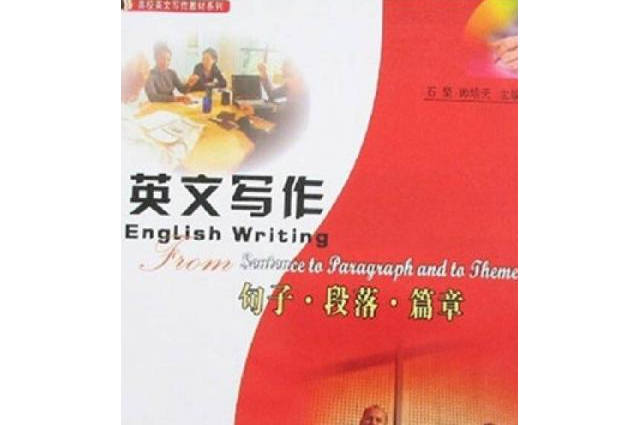《英文:句子·段落·篇章》是2006年四川人民出版社出版的圖書,作者是石堅、帥培天。
基本介紹
- 書名:英文:句子·段落·篇章
- 作者:石堅、帥培天
- 出版社:四川人民出版社
- 出版時間:2006年5月1日
- 頁數:274 頁
- 定價:29.00 元
- 開本:16 開
- 裝幀:平裝
- ISBN:9787220073472

《英文:句子·段落·篇章》是2006年四川人民出版社出版的圖書,作者是石堅、帥培天。
《英文:句子·段落·篇章》是2006年四川人民出版社出版的圖書,作者是石堅、帥培天。內容簡介 高校英文寫作教材系列。《高校英文寫作教材系列·英文寫作:句子·段落·篇章》分為四大部分。第一部分為英語寫作知識與技巧概述,...
《英文寫作-句子·段落·篇章》是2006年四川人民出版社出版的圖書,作者是石堅、帥培天。內容提要 全書深入淺出,以第一人稱寫成,充分體了人文精神,讓使用者以平等的射份參與問題的討論,增強寫作地道英語短文的自信心。各章節均配有大量練習,練習難易有致,教師和學生可以自由取捨,靈活選用。練習編排採用了“預測...
《英語寫作-句子·段落·篇章》是2010年外語教學與研究出版社出版的圖書,作者是石堅、 帥培天。內容簡介 《高等學校英語寫作進階系列·英語寫作·句子段落篇章》介紹:從事高校英語寫作教學及研究多年,一直嚮往一整套供師生從低年級到高年級使用的寫作教材。這套教材應包括基礎英語寫作、英語套用文寫作和高級階段的英語...
單句寫作是英語寫作的基本功。在一個句子中,每個詞語都和其它詞語發生關係,互為語境,而句子本身則處於孤立狀態。所以當我們翻譯各個詞語時,要做到相 互協調,前後一致,邏輯嚴謹;而當我們對句子做整體處理時,就享有一定靈活性,也許能夠給出多種恰當的譯法,而這些譯法分別適用於不同的段落或篇章語境。 無論在...
《大學英語實用寫作教程》是2009年9月重慶大學出版社出版的圖書,作者是張梅。內容簡介 《大學英語實用寫作教程(語言技能類)》旨在幫助學生在較短的時間內除了掌握英語寫作中的詞、句子、段落和篇章的基礎知識外,更要掌握如通知、便條、海報、書信、履歷、摘要、讀書報告以及演講辭等常見套用文的寫作方法與技巧。《...
賞讀美文不僅會激發學習者的興趣,而且還會點燃學習英語的熱情,把英語學習提高到審美和益智的層面上。為了順應英語學習循序漸進的規律,本書在編排上的突出特點是從易到難。從比較基礎的經典句子人手,到琅琅上口的段落,再到富有哲理、意境優美的詩歌和篇章。這樣的編排方式有助於培養讀者的信心,讓讀者在朗讀的過程...
因此,模仿新概念的經典句子、段落甚至篇章結構,添加趣味性、個性化和情景式的內容,將會有效地提高你的寫作能力。下面是一篇將新概念英語第三冊第九課“Flying cats”改寫的範例:Fascinating New Concept English Lessons of New Concept English never fail to fascinate their learners. They can be useful and ...
前兩章分別討論提高寫作能力的重要性和中國學生用英語寫作的困難所在。第三章介紹寫作過程。四、五兩章討論篇章寫作,其中第四章是針對中國學生在中級階段的需要與可能,集中介紹個人經驗短文和個人意見短文兩類作文的寫作,第五章則是按傳統文章分類討論各種文章的寫作。第六章討論有關寫作段落的問題。第七、八兩章...
(四)雙重被動態 1.被動態不定詞主語補語構成雙重被動態 2被動態分詞作主語補語構成雙重被動態 (五)主動句改成被動句的方法 1.陳述句各種時態收成被動句的方法 2.帶情態助動詞的句子改成被動態:“情態助動詞+bc+—d/—t/—n分詞”3.祈使句改為被動態的方法 4.感嘆句改為被動態的方法 ...
為幫助親愛的讀者更快更好地提升英語閱讀能力,我們隆重推出了“讀名著學英語”閱讀書系。可以說,這是為英語愛好者量身打造的“完美雙語讀本”。在選材上,我們不僅精選了世界各國最知名最優秀的作家的代表作,還挑選了經過時間積澱和驗證而流傳下來的優秀作品,同時也選取了當下最新穎最出色的流行篇章,讓親愛的讀者...
《2014考研英語高分策略:翻譯與句型結構專項特訓》是一本專門針對考研英語翻譯與句型結構專項特訓的圖書。全書在寫作方面,由理論到實踐,可以幫助考生全面突破翻譯難題。作者獨創句子結構分析法,精心歸納了英語的句型結構,並悉心傳授了英漢翻譯的技巧。除此之外,《2014考研英語高分策略:翻譯與句型結構專項特訓》還全...
《新東方·高考英語閱讀模考100篇》所收錄的大部分文章均與高考的平均難度持平或者高於高考的難度,附有官方標準答案及詳盡解析,對文章和題目中出現的生詞進行了全面歸納,對英語篇章進行了精到的全文翻譯,此外,譯文部分還標有新東方一線名師對要點句、解題線索的精彩點評,幫助考生掌握科學的解題思路。相信通過學習本書...
內容(章節)提要如下(成書前部分章節會有所調整):閱讀部分:1 新英語專業四級考試大綱剖析;2 體裁題材分析;3考點分析;4長難句分析;5 模擬訓練與拓展。寫作部分:1.主要訓練字詞,2.訓練句子,3.訓練段落,4.訓練篇章,5.高分內容。兩部分都按照新專四題型和大綱要求設計若干套模擬訓練題,除了提供詳盡的...
《高等學校英語專業系列教材·英語論文寫作入門教程》是2008年1月1日清華大學出版社,北京交通大學出版社出版的圖書。內容簡介 《高等學校英語專業系列教材?英語論文寫作入門教程》是一本英語論文寫作的入門教科書,共10個單元,內容包括對論文的界定、選題方法、研究過程,書目卡和文摘卡的製作、列提綱的方法、論文的...
文本,是指書面語言的表現形式,從文學角度說,通常是具有完整、系統含義(Message)的一個句子或多個句子的組合。一個文本可以是一個句子(Sentence)、一個段落(Paragraph)或者一個篇章(Discourse)。廣義“文本”:任何由書寫所固定下來的任何話語。(利科爾) 狹義“文本”:由語言文字組成的文學實體,代指“...
自然語言處理( Natural Language Processing, NLP)是人工智慧領域的重要研究方向, 融合了語言學、計算機科學、機器學習、數學、認知心理學等多個學科領域的知識,是一門集計算機科學、人工智慧和語言學於一體的交叉學科,它包含自然語言理解和自然語言生成兩個主要方面, 研究內容包括字、詞、短語、句子、段落和篇章等多...
已發表學術論文近30篇(其中核心期刊論文10篇),與人合作編撰有《WTO英文法律文本語言特點與翻譯研究》《實用英漢翻譯》《英語寫作規範》《英語套用文寫作:走進美國》《英文寫作一一句子,段落·篇章》等多部學術專著和教材。承擔科研項目10餘項(省廳級5項,主持2項),市級9項(主持2項),科研獲獎7項(其中專著...
2010年。石堅、帥培天、王欣:《高等學校英語寫作進階系列:英語套用文寫作(走近美國)》,外語教學與研究出版社,2011年。石堅、帥培天、王欣:《英語寫作規範》,外語教學與研究出版社,2011年。石堅、帥培天、王欣:《高等學校英語寫作進階系列:句子·段落·篇章》,外語教學與研究出版社,2010年。
因為這是一種較淺水平的信息處理,然而,如果朗讀一個句子幾遍之後,就試著回憶剛剛讀過句子,則更容易記住。對段落和篇章的記憶也應採用同樣的方法。因為,對信息的加工水平越深,信息就越更長時間地保留在記憶中。曹日昌先生 (1964:244) 指出,“試圖背誦,一方面由於學習者的積極活動,可以提高更多的建立聯繫的...
句子、段落和篇章 68 第5章 養成寫作的習慣 76 培養自信和熱情 76 即時寫作 79 合作寫作 91 相互寫作 100 如何對待"寫作習慣培養"的習作 104 第6章 寫作的過程 107 過程和語體 107 激發創意 108 分析語體 113 構思 115 過程寫作順序示例 116 項目作業 128 為考試而寫作 130 第7章 反饋、...
規則6.勿將句子一分為二 規則7.位於句首的分詞短語的邏輯主語須與該句語法上的主語一致 第三章 英語寫作的基本原則 規則8.篇章要以段落為單位:一段一主題 規則9.通常,以一個主題句來開始一個段落,並在結尾處首尾呼應 規則10.使用主動語態 規則11.用肯定形式來陳述 規則12.使用清晰、明確、具體的語言...
目前市場上四、六級的作文指導書多側重結構、範文和語法,而側重於句子和用詞方面的書見得不多,關於作文修改的書也很罕見。希望《新東方?手把手教你4?6級作文》能夠填補這個空缺,給同學們提供實際的幫助。添加連結:點擊連結進入:新東方?手把手教你四六級作文 目錄 第一章 段落結構的問題 第二章 句子的問題 ...
主要涵蓋四個方面的內容:一、文化和語言之間的關係(其中包括文化概論、文化與語言之間的關係);二、翻譯概論(其中包括翻譯的定義、翻譯的過程和翻譯的常用策略等);三、英漢語言文化比較研究與翻譯(其中包括英漢語音比較及英源音譯詞研究、英漢辭彙比較與翻譯、英漢習語比較與翻譯、英漢句子比較與翻譯、英漢篇章比較...
真經寫作之經典段落 真經寫作之必備篇章結構 雅思寫作真題題庫 社會類問題 快餐食品危害巨大 廣告影響個人 建築風格 銀髮危機 兒童廣告 環保類問翹 保護環境人人有責 燃油加價促進環保 減少航班降低污染 政府類問題 開發中國家開發旅遊 政府還是盈利機構經營醫療 住房緊缺政府有責 科技類問題 網上交易 大學課堂VS.教育...
part i 段落漢譯英應試技巧 第一章 翻譯新題型介紹 一、題型介紹 二、如何備考 三、考場答題步驟 第二章 漢譯英翻譯9個技巧 技巧1:了解中英文區別,避免機械對等翻譯 技巧2:從動詞入手理清句子主幹,確定修飾成分 技巧3:如何確定時態 技巧4:根據語境及搭配選擇用詞 技巧5:巧妙處理難詞 技巧6:根據篇章邏...
語法選擇題中包含25道改進句子(Improving Sentences,下稱IS)、18道句子挑錯(Identifying Sentence Error,下稱ISE)和6道改進篇章(Improving Passage,下稱IP)。搭配形式 Section 1(25分鐘):作文[;註:每次考試,第一個區肯定是25分鐘作文];25分鐘區:11道IS+18道ISE+6道IP Section 10(10分鐘):14道...
第三節 句子、段落和篇章的結構 一、微命題結構 二、宏命題結構 三、上層水平的結構 第四節 篇章分析系統 一、西方主要的篇章分析系統 二、故事語法 第七章 圖式理論與篇章閱讀 第一節 魯墨哈特的圖式理論 一、什麼是圖式 二、圖式的控制結構 三、圖式的主要功能 第二節 圖式在篇章不同水平加工中的作用...
具體而言,按照題材記憶,有利於考生在看到某一話題時,迅速在大腦中搜尋與該話題相關的辭彙;而按照詞性記憶,則有利於考生在具體創作時,寫出合乎語法規範、表意準確無誤的句子。(二)搞定5大英語基礎句型 很多考生在剛開始複習寫作時,就致力於寫出“結構多變、句式豐富”的文章。但是,假如你的基礎並不紮實,則很...
在本書的文法篇章中不時會穿插一些欄位,額外補充與德語相關的小知識,以及解說該章節所學到的相關文法重點若在德語字典中要如何查詢的到,加深讀者對於德文的深入了解。圖書目錄 第0章 段落與句子之構成要素 1. 段落 2. 句子與句子元素 3. 詞組 4. 詞類 第1章 動詞 1. 動詞的特性 2. 時態 3. 動詞的...
馬克思(Karl Marx,1818—1883)和恩格斯(Friedrich Engels,1820—1895)是無產階級的偉大導師、科學共產主義的創始人。馬克思主義的產生引發了科學和社會領域裡的一系列變革,教育理論從此掌握了科學的武器,揭開了教育發展的新篇章。志同道合是友誼的堅實基礎(馬克思與恩格斯的偉大友誼)1844 年,馬克思在巴黎期間,...
